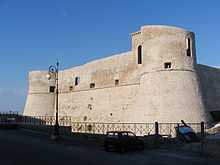Ortona
| Ortona | |
|---|---|
| Comune | |
| Città di Ortona | |
|
A view of Ortona from the sea. | |
 Ortona Location of Ortona in Italy | |
| Coordinates: 42°21′N 14°24′E / 42.350°N 14.400°ECoordinates: 42°21′N 14°24′E / 42.350°N 14.400°E | |
| Country | Italy |
| Region | Abruzzo |
| Province | Chieti (CH) |
| Frazioni | Alboreto, Aquilano, Caldari, Colombo, Cucullo, Feudo, Fontegrande, Foro, Fossato, Gagliarda, Iurisci, Lazzaretto, Lido Riccio, Madonna delle Grazie, Ranchini, Riccio, Ripari Bardella, Rogatti, Ruscitti, San Donato, San Leonardo, San Marco, San Pietro, Santa Lucia, Savini, Tamarete, Vaccari, Villa Deo, Villa Grande, Villa Iubatti, Villa Pincione, Villa San Leonardo, Villa San Nicola, Villa San Tommaso, Villa Torre |
| Government | |
| • Mayor | Vincenzo D'Ottavio |
| Area | |
| • Total | 70 km2 (30 sq mi) |
| Elevation | 72 m (236 ft) |
| Population | |
| • Total | 24,911 |
| • Density | 360/km2 (920/sq mi) |
| Demonym | Ortonesi |
| Time zone | CET (UTC+1) |
| • Summer (DST) | CEST (UTC+2) |
| Postal code | 66026 |
| Dialing code | 085 |
| Patron saint | St. Thomas |
| Saint day | First sunday of May |
| Website | Official website |
Ortona is a coastal town and municipality of the Province of Chieti in the Italian region of Abruzzo, with some 23,000 inhabitants.
Ortona was the site of fierce fighting between the 1st Fallschirmjäger Division and the 1st Canadian Infantry Division during the Italian campaign in World War II. The ferocity of the battle led it to be known as the "Little Stalingrad" (See Battle of Ortona).
History
The origins of Ortona are uncertain. Presumably, it was first inhabited by the Frentani, an Italic population. In 2005, during works near the Castle, a Bronze Age settlement was discovered, and the Roman town largely coincided with this first settlement. Some sections of paved roads and urban walls, as well as some archaeological findings are the only remains of this period. Ortona remained a part of the Roman Empire (i.e., the Byzantine Empire) for several centuries, before it was annexed by the Kingdom of the Lombards. In 803 the Franks incorporated Ortona into the county of Chieti. From that date on, the town remained tied to Chieti and its territory.

In 1258 the relics of the Apostle Thomas were brought to Ortona by the sailor Leone Acciaiuoli. In the first half of the 15th century its walls were built, and during this period Ortona fought with the nearby town of Lanciano in a fierce war that ended in 1427. On June 30, 1447, ships from Venice destroyed the port of Ortona; consequently the King of Sicily at that time commissioned the construction of a Castle to dominate the renovated port. In 1582 the town was acquired by Margaret of Parma, daughter of Emperor Charles V and Duchess of Parma. In 1584 Margaret decided to build a great mansion (known as Palazzo Farnese), which was never completed due to her death.

After the establishment of the Kingdom of Italy in 1860, Ortona became one of the first sea resorts on the Adriatic sea. On 9 September 1943, the royal family of the House of Savoy left Nazi-occupied Italy from the port of Ortona. The defensive Gustav Line was established by the Germans at Ortona (extending towards Cassino on the opposite side of Italy). Although only a small town, Ortona offered the Allies a supply port on the Adriatic and was fiercely defended by the Germans attracted the attention of that the international press in the struggle between the German paratroopers and the 2nd Canadian Infantry Brigade. This led to this battle being known as "Little Stalingrad."
Main sights
Ortona is home of several pleasant beaches and one historical museum based on the battle of Ortona. The Parco Nazionale d'Abruzzo is not far either.
International relations
Twin towns – Sister cities
Ortona is twinned with:
 Cassino, Italy
Cassino, Italy
Culture
The composer Sir Francesco Paolo Tosti was born in Ortona.
Actors
The well-known hard-core pornographic actor and producer Rocco Tano (Siffredi) was born in Ortona.
See also
Notes
References
- Christie, N. M. (2001). Hard-won Victory: the Canadians at Ortona 1943. Ottawa: CEF Books.
- Zuehlke, Mark (1999). Ortona: Canada's epic World War II battle. Toronto: Stoddart.
External links
| Wikimedia Commons has media related to Ortona. |
| Wikisource has the text of the 1911 Encyclopædia Britannica article Ortona a Mare. |
- The Battle of Ortona - The "Italian Stalingrad" - December 20-28, 1943
- Inside Abruzzo: Insider Tips Uncovered
